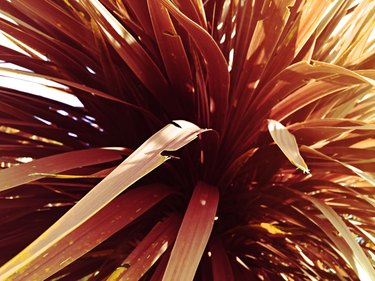
Cordyline red spike (Cordyline australis 'Red Star'), also called red star dracaena, is a striking feature for your garden with its long burgundy leaves. This Cordyline species is also called a cabbage tree. This species is easy to grow in the ground or in a container, but it must be protected from frost. Red star spike grows in U.S. Department of Agriculture plant hardiness zones 9 to 11.
About Cordyline Red Spike
Video of the Day
Cordyline australis is a large perennial tree that is native to New Zealand and Australia. It has green leaves and grows up to 15 feet tall. Cordyline 'Red Star' is a smaller cultivar, growing only 8 to 10 feet. It features uniquely colored red leaves and can be grown in containers in colder climates.
Video of the Day
Take care when adding this plant to your home or garden because it can be mildly toxic to humans and pets, including cats and dogs. It does not cause contact dermatitis, but if ingested, it can result in vomiting, increased salivation, depression and anorexia. If your cat gets into the plant, you may also notice dilated pupils.
Cordyline 'Red Star' is a low maintenance plant with few demands. With proper care, the plant rarely has problems.
Red Star Care Requirements
In warm climates, you can plant Cordyline 'Red Star' directly into your garden. However, in USDA zones 8 and below, plant the tree in a large container to make frost protection easier. Select a large, deep container to allow room for the tree's long taproot. Repot the tree every two to three years.
Position the plant in a location that gets full to part sun. The cabbage tree can grow in a wide range of soil types and will tolerate both wet and dry soil. However, to keep your tree healthy, it is best to plant in well-drained soil and water regularly to keep the soil moist. You can decrease irrigation during the winter months.
If freezing temperatures are expected, move the tree indoors to protect it from cold. The tree may drop its leaves if frost damage occurs. The tree naturally sheds old leaves, so pruning is not required. You can fertilize once per year in the spring with a balanced fertilizer.
Cabbage Tree Problems
With proper care, Cordyline 'Red Star' has few problems and is not prone to disease. Pests are rarely a concern but are more commonly seen on indoor plants. Some pests for which to watch include mealybugs, scale and spider mites.
Mealybugs are small, pale, slow-moving insects found on the underside of the leaves. They feed on the leaves and leave behind honeydew, which provides ideal conditions for sooty mold. Wipe the leaves with a cotton ball soaked in rubbing alcohol to remove the pests. You can also try spraying the plant with insecticidal soap, although in the case of a severe infestation, it is often best to get rid of the plant and start again with a healthy specimen.
As the name implies, scale insects look like scales on the leaf surface. These pests also secrete honeydew. You can manually scrape the bugs from the plant. Adults are not susceptible to insecticides, but they can be used to kill young scale pests. Spider mites are extremely small pests that may not be visible to the naked eye, but you may see speckling on the leaves and webbing on the plant. Wash spider mites from the plant with a stream of water and treat the plant with insecticidal soap or neem oil.
- University of Florida IFAS Gardening Solutions: Red Star Dracaena
- Missouri Botanical Garden: Cordyline australis
- North Carolina State University Cooperative Extension: Cordyline australis
- National Gardening Association: Cabbage Tree (Cordyline australis 'Red Star')
- Royal Horticultural Society: How To Grow Cordyline
- Clemson University Cooperative Extension Service: Common Houseplant Insects & Related Pests